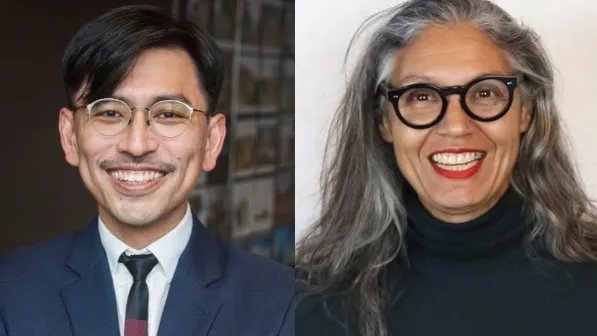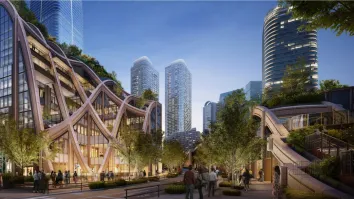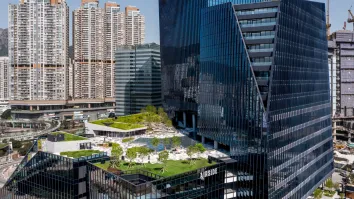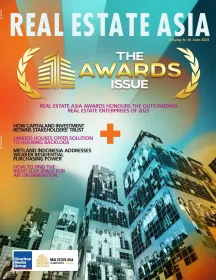
Benoy bets on sustainability as it transforms environments
Designers must be adaptive to the changing times in creating spaces.
International architecture firm Benoy has been involved in some of the biggest projects and landmarks around the globe. In Singapore, Changi Airport Terminal 4 (T4) has set a new global benchmark for the modern airport environment since it opened in 2018. Within two years, it won numerous design awards and received multiple five-star ratings from Skytrax.
Meanwhile, Jewel Chang, which opened in April 2019, is an internationally award-winning 37,000 sqm gateway and lifestyle destination that features an indoor forest valley and majestic waterfall.
For Jewel, Benoy formed part of a world-class consortium led by CapitaLand, with Safdie Architects as lead architect. Involved in the retail interior design and retail and aviation facility planning, Benoy created a unique and dynamic interior retail environment covering 137,000 square meters of retail, hospitality, dining and leisure spaces including lounges, a hotel and a cinema. It also contains 280 units over six levels; including flagship F&B and retail or brands unique to Singapore.
Familiar malls and tourist favorites in other parts of the world are also included in Benoy’s portfolio. In Japan’s top shopping district, the Shibuya PARCO store that opened in November 2019 is a redevelopment of the department store that launched in 1973.
According to Benoy, the refurbishment brief included design for a total built area of 64,000 square meters, with 42,000 square meters of retail space spread across 11 storeys consisting of high-end shops, F&B, experiential attractions, theatres and cinemas.
Over at Sanya CDF Mall Phase II in China, the mixed-use commercial project became the first and only development of this type in Hainan province.
Similarly, David Jones Elizabeth Street flagship store in Sydney’s Hyde Park District was rejuvenated by Benoy to keep its experiential luxury retail environment which first launched in 1927, whilst in Bangkok, Thailand they designed Icon Siam as a place that will be able to showcase the Chao Phraya River while integrating the shopping experience that the city is well known for.
Head of Benoy Hong Kong, Singapore, and Shenzhen Terence Seah said that taking into consideration both the commercial value and the impact it will bring the local community, they aim to provide mutual benefit in building these developments.
“In these retail developments, we further blurred the boundary between shops and common public areas, altering the psychology of shopping. We transformed dull leftover public spaces into experiential zones where both permanent and ad-hoc events could take place,“ he said.
“We've also been working on a couple of experiential retail destinations in Bangkok and quite interestingly, a lot of these look at the existing communities. We look at how we can find ways to positively impact it and bring commercial value, but at the same time to kind of stitch the community and bring mutual benefit for the development,” he added.
Seah shared that the architecture firm is currently part of the upcoming projects in Alibaba Jiangsu Headquarters, Nanjing, China and Mimosa Filinvest Lifemalls, Clark City, Philippines. The Alibaba Jiangsu Headquarters has a total investment value of over CNY 8 billion, and is designed to accommodate 30,000 people. It is a major mixed-use development with a gross floor area of 850,000 sq. m.
It is described as a benchmark for mixed-use smart city projects. Likened to a network that can connect people, places, data, and experiences, its architecture facilitates the reduction of CO2 emissions by integrating its logistics.
Meanwhile, Mimosa Filinvest Malls is a former military base being developed into a new leisure destination. Taking inspiration primarily from its natural surroundings and Mimosa trees, the mall will have three zones: Mimosa Avenues, Hanging Gardens, and The Treetops.
Envisioned as a ‘village in the park’, the mall centers on having natural light, open air streets, and an elevated treetop walkway that will directly connect the buyers to lush landscapes.
The architectural firm said that Mimosa aims to create spaces for people and community that will promote interaction, health and well-being, and happiness through the introduction and improvement of the existing amenities and open spaces.
“In a way, we were not only interested in the idea that the building needs to be sustainable from an ecological point of view, or whether it contributes to energy consumption and comfort, but also from a social aspect. How do we get that design from a human and a communal kind of perspective?” he said.

(L-R) T4 Changi Airport, and Jewel Changi in Singapore
Sustainable by default
For Deborah Nagan, Global Sustainability Lead for Hanley House, the parent company of Benoy, work will be business as usual post-COVID, but in a more conscious manner.
“With so much slowing down and stopping, I think we've all been more sustainable by default. One of the positive effects of the pandemic is the sense that we all need to be healthy, and for humans to be healthy, we have to have a healthy planet. Every very little thing we do has an impact on that,” she said.
“So I suspect that as we return to what's going to be called business as usual, in a way, is not business as usual. We're all trying to do a little bit better here and make sure that we and our families are healthier,” she added.
As designers, Nagan said that their role goes beyond simply implementing what the client requires. In the changing times, especially in the new normal and considering our current climate, there is a need to be more environmentally conscious. By integrating these aspects together, Benoy aims to bring a difference through their designs.
“I think we really can help. One of the things that we are doing quite closely now is looking at what people actually do. It requires behavioral change in individuals, as much as it requires us working in real estate and property to change the way we make projects,” she said.
Illustrating as an example the use of the air conditioning in commercial spaces, the pandemic introduced changes which made people accept necessary shifts to be more conscious of the energy being used and behavior in general.
“We have become conditioned prior to the pandemic to having nice cool interiors, really ramping that temperature down when in fact, it's not terribly helpful. It not only uses more power,” she said.
“Rethinking our behavior, slightly turning the temperature gauge in the other direction for once, this is one of the biggest changes we can make to our energy consumption, consumption in buildings and across large cities where air conditioning is in use 24 hours a day. That is a massive saving in energy,” she added.

(L-R) Shibuya PARCO in Tokyo, Japan; Sanya CDF Mall, Hainan, China; David Jones Department Store in Sydney, Australia
Societal shift
More than listening to reports and upcoming plans of shifting to the idea of going to the physical office only on certain workdays, Nagan thinks that it is better for designers to be more flexible and adaptive to the different possible changes that might happen with work spaces.
“I think that we are capable of making the right choices. Similarly, you can see developers saying people aren't going to go to the office all the time. Let's not plan for that future. Let's plan for a future where we're flexible people more capable of making up our own minds about where and how we work, and no less productive for it,” she said.
“That puts power back in the hands of the individual and the business before it has to be told what to do within a regulatory or a government framework, and I think that's a very, very interesting shift in societal thinking,” she added.
Benoy sees a shift to a more flexible working style, not just for offices but also for the employees. Some may opt to have both remote and physical options for work, whilst some may prefer to have a new model altogether such as moving into collaborative or shared spaces.
Nagan is hoping that there will be more sharing of resources within spaces, such as having common kitchens and lifts.
“There's a trend that we haven't really heard much about yet. As businesses are trying to slim down the amount of office space they use, what I'm hoping for is that we also see more sharing of resource. We don't all need our own office with our own kitchens, or our own lifts and our own admin infrastructure,” she said.
“I think the future for shared workspaces, and a more collaborative form of working, actually looks quite bright. We like to create the circumstances where people come together then the next great technological idea is born through that chance encounter. Flexible working opens up a world of rethinking because you are working in a more unexpected way, a more agile way and with people you may not come into contact with before. So I'm very hopeful about flexible working,” she added.

(L-R) ICONSIAM in Bangkok, Thailand; Mimosa Filinvest Lifemalls in Clark City, Philippines
Value of good design
There is good in being more sustainable in design. Financial incentives such as green loans are available to encourage more developers to adapt to more sustainable constructions and designs. Seah shared this is attainable by looking into the social and environmental value of having good designs.
“You have things like green loans, which is very interesting. Understanding the value, which is often not captured purely from a financial instrument, is kind of an analysis about the social value, the environmental value of good design,” he said.
In Benoy’s decades of designing commercial spots and destinations, the firm has grown to know that it is important to factor in the good practices when creating new projects. They have been able to build long-lasting structures which people still go to and visit even years after it has launched.
By putting into consideration the economic, social, and environmental values in design, they are able to create memorable and sustainable destinations.
“We've been examining what we've been doing for over 70 years and the last 21 years in Asia. I think what we recognize is we always are able to create places. We call them destinations but really they are places that people all love. People just want to come back every time and they're also incredibly successful commercially,” he said.
“What we discover is these spaces are a little bit like a social glue. So, what we think is very important is to really objectify that kind of relationship with real estate which needs to have economic value. With social value as well as the environmental value, when you look at all three in a kind of holistic way and how it works with each other, will produce these kinds of places that are always very enduring,” he added.
Photos courtesy of Benoy.
(L-R: Terence Seah, Head of Benoy Hong Kong, Singapore, and Shenzhen; Deborah Nagan, Global Sustainability Lead for Hanley House)


















 Advertise
Advertise


